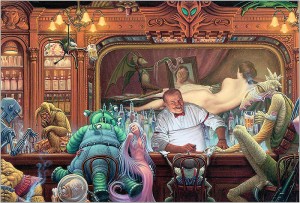
Well here I am, back again after an hiatus of four months. I feel guilty for not jumping back into the game earlier but, you know, sometimes life throws you some curve balls and you end up too distracted to focus on blogging.
That said, here I am and . . . wow! What a time to return to the Amazing Stories fold! Talk about distractions. . . how can I get back to mini-treatises on collecting art when there’s this fracas going on about the Hugos? Especially when, thanks to George R. R. Martin, I am a fully fledged member of the highly prestigious “Hugo Losers” club? (for readers who are not aware, in 1976, for Kansas City’s MidAmeriCon, the 34th World Science Fiction Convention (Worldcon), Martin and his friend and fellow writer-editor Gardner Dozois came up with the idea of a Hugo Losers’ Party for the benefit of all past and present Hugo-losing nominees, the evening following the convention’s Hugo Awards ceremony – an event I’ve greatly enjoyed attending).
Oh, If only puppies were not puppies – and were able to digest Martin’s eminently well-researched and readable “Not a Blog” dealing with what some are calling the hijacking of the Hugos by politicizing the process of nominating and voting for the winner. Or had the maturity to empathize with Connie Willis’s heartfelt views on why SHE won’t be presenting at the Hugos this year! Then again, puppies are, after all – and by definition – very young dogs, and pups are expected to demonstrate puppy behavior. Indeed, if you are looking at the young of any species and expecting the perspective granted by age….including, but not limited to, some demonstration of wisdom, you are going to be disappointed. At the same time, anyone who loves puppies can’t help but be entertained by their antics. Want a cure for boredom? Get a puppy. 🙂
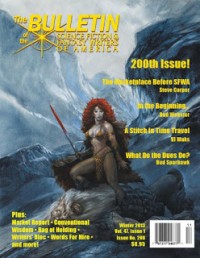
I got the first hint that we were all getting too bored with things as they were – and fellt compelled to stir the pot – with the silly brou-ha-ha about the Jeff Easley cover on the SFWA Journal. It was a portent. Of just how silly people can be. And now . . . there’s this. Oh, I know, some people don’t think that complaining about depictions of gals with big boobs on the cover of an association’s journal isn’t silly. But to me? Not in any way significant enough to remove the sitting President. But back to the Hugos . . .
It’s not as if anyone LIKES being a loser, or not getting on the ballot as nominee. It’s just that – and speaking as a fringe member of the literary set – this award means less to some people than to others. When art collectors get together and talk about the field “going to the dogs” they ain’t talkin’ about “puppygate”. 🙂
And It’s not that attempts to skew Hugo outcomes have been solely the province of that literary set. Lobbying to get certain (overlooked) artists on the ballot has been attempted, as well. In years past I’ve been approached to participate in these efforts, to garner support (assuming I had such influence!) from other voters I knew, and get them to nominate one artist or another. I guess I was seen as the perfect lobbyist for such a cause, considering I was then selling original art for such well –known (but never nominated) artists as John Berkey, Paul Lehr, Darrell K. Sweet. To name just three . . that never enjoyed that honor during their lifetimes.
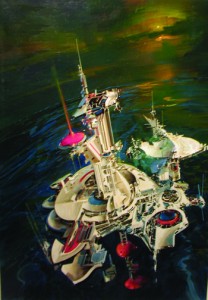
Not that such efforts would have been without merit, or weren’t well-intentioned. But even I – an outsider who actually never minded the objectification of women AND men on the covers of books and magazines (how else are you gonna get young men to READ, duh?) – knew enough to know that such lobbying was simply NOT DONE. Voting has always been an individual thing – and I never had any interest in influencing the votes of others. Indeed, I have always been able to act as has been suggested by others. That when I wasn’t familiar with the work, if I hadn’t read the story, if I never heard of the artist, saw the TV episode or movie, I just didn’t vote for it.
Did it occur to me that by opting out of voting for a category, others could get together and use their votes to skew the results? Sure. Just as it occurred to me that hyperbole was the way SF/F got sold. Monsters are “over the top,”, the horror is garish and shocking, the sex is as lurid as publishers can get away with, and, well, “colorful” to the point of grabbing your eyeballs and not letting go. That’s a big part of what has made the world so damned fond of SF/F.
But putting that radical notion aside for a moment, I still didn’t think it was my place to tell others who they should nominate for a Hugo. Anymore than I think it’s my place to tell collectors what paintings to buy. All I can do, all I can ever do, is offer for sale as wide a range of art by artists that I consider “worthy” of collectors’ attention – and then leave it to them to choose. What that has translated into is representing more than 35 artists over time, and over 4000 works of art sold since 1991, and STILL no consensus over who is the BEST. There is no “best” for everyone, just the best for YOU. And that is “generational”. As in: you collect what you grow up with, the imagery you are familiar with, that pushes your nostalgia button when you finally get to that point in your life when you have the money and the time and walls . . . sufficient to display the art. Which brings us back to the popularity contest we call the Hugos and the award for Best Professional Artist (as the award is known today)
BEST??? Are you kidding me??? That’s like saying the Worldcons really span “the World” when it comes to nominations . . .
How do I know this? Well for one thing, the Hugo for Best Artist has been awarded for, what, almost 60 years? And how many of the hundreds of artists working in the field over that period have won? Less than 20? You do the math.

All through the 1980s, a time when a stunning number of talented artists were entering and working in the genre, Michael Whelan won the Hugo. Indeed, he has won this award more times than anyone else, almost 20% of the time, one-fifth of all the Hugos — in a field (as I’ve said) that has demonstrably been supported by the talents of hundreds of potential winners. Was this Whelan’s doing? Or a cabal of insiders who manipulated the votes? NO. Everyone knew and liked Whelan for his art as much as for his long-standing contributions to the field. He showed up. Over and over again, he and Audrey showed up. And with their kids. In the minds of people who read the books, his work stood out, his name was known, he was liked. And that mattered to the voters. He was more popular, and even if other artists grumbled, no one even dreamed of stacking the deck so that he woudn’t win.
And so what? Why shouldn’t it be this way? Is there anything wrong with voting for popular artists, so long as they’re good? [and see Hugo winner John Picacio’s very nice review of the winners, back in 2012.]
If you don’t care to mingle with fans of your work, if you have no patience for conventions, if you basically consider sf/f illustration just another commercial assignment among many – or if you limited yourself to conventions that were close enough to home that you could hang your art on a Thursday and return on a Sunday to take it down….then regardless of your artistic talents – why should those fans reward you with honors? As Woody Allen has said “80% of life is showing up”
John Berkey was never nominated, but guess what? He never lost any sleep over it. Paul Lehr was nominated once, but it didn’t compel him to show up at cons in California to influence potential voters. [author’s side note: links provided only for living artists maintaining personal websites; other artists mentioned sell through various galleries or secondary market sources] Ron Walotsky was a fixture at cons…as were many others who showed up, year after year but it didn’t get them anywhere near a ballot, either. And don’t even get me started on the Brits: throwing the win to Jim Burns a couple of times as a “tradition” whenever the Worldcon went to the UK but otherwise? What about Roger Dean, Chris Foss, or/and (most recently nominated) John Harris? The list of well-known, talented British artists is incredibly long and rich…the UK publishing market, historically, a very strong one….but they were ignored. Then there were those artists who showed up, but weren’t exactly “present”. They did it to show their portfolios to art directors, to get jobs, to sell prints, or hobnob with other artists…not because they wanted to be popular with fans who might nominate them for the Hugo.
BUT…. BUT wait. What about those who showed up, AND were liked, AND did great work? And who were either never nominated, or never won? Weren’t there some egregious oversights? Sure.
We might as well name a few. You’ll probably recognize their names. Richard Powers, Jeff Jones. James Gurney. And all the rest of the guys from the 80s (not in any special order) who never got nominated, or nominated but never won: James Warhola,Tom Kidd, Dean Morrissey, Steve Hickman, Barclay Shaw, David Mattingly, Joe DeVito or Richard Bober. By now you’re probably coming up with a few names of your own. Artists who showed up plenty, but never got the nod…especially those in the Midwest, or on the West Coast.
It wasn’t some group’s secret mission to keep them off the ballot. Voters just liked Whelan more. He contributed to the field in ways more than just as an artist (Pres of the Society of Illustrators, NY, for example) He was ubiquitous at conventions. He dominated the book illustration market. He was, in a word, not only a great artist, but also more POPULAR than the rest. So when it came time to voting, guess what? And politicizing the “slate” so that Whelan would be off the ballot wouldn’t have changed that basic fact. You can run slates so that popularity is determined by bloc voting, but that would only have caused hundreds of fans to scratch their heads and wonder what the Hugo was for, anyway. If not to reward someone or something that the majority of fans were familiar with and loved PERSONALLY.
But here’s the real kicker does NEVER being nominated – or winning – really make any difference? I think you can guess the answer to that one. John Berkey and Richard Powers never won, and their work commands more than Bob Eggleton, who did – many times. Why? Partly because Berkey and Powers are dead and Bob is most decidedly not. And why did Bob win? He went to World SF, World Horror, World Fantasy, regional cons, Chiller (NJ) and scads of others. Everyone knows Bob. Everyone loves Bob. Nevertheless, Powers and Berkey are as collectible as John Schoenherr (who ALSO never won), or the Dillons and Jack Gaughan (who both did). In fact worth much more than Gaughan! Who incidentally is also deceased 😉 So “dead guy art” is not necessarily worth more 🙂 And are you going to tell me that Chesley Bonestell (nominated 1968) is a worse artist than Gaughan, who WON that year? Non winners Boris Vallejo and Julie Bell, Tom Canty Jeff Jones, for ghu’s sake, aren’t they as “good” as Emshwiller? Who won? Has not winning influenced their reputation as artists, their status in the field, their collectability among sf/f art collectors?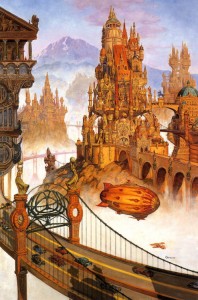 NOPE.
NOPE.
I realize this is not the argument that I’m supposed to make. I’m supposed to be saying how important it is for popularity NOT to skew the awards, how we need to rectify the “problem” of certain artists dominating the ballot, year after year. So that certain other artists “don’t get left out”. Or (thanks, Puppies), how important it is that we don’t let one segment of fandom or another make the Hugos into a battlefield. I won’t do it. If it turns into a battlefield, then maybe it’s time to re:think what it means to be a ‘fan’ today. And what we’re prepared to do, as fans, to maintain the honor of the win, and of the traditions that ride alongside that honor.
Well here’s a different perspective: Who cares any more? I certainly don’t. And I say that with regret. For years, the illustration industry that gave artists a living wage has been transitioning from one based on commissions for painted art (traditional media) into one based on graphic design and digitally created art. Artists who paint have no reason to attend Worldcons any longer except for camaraderie…because they aren’t getting jobs that way, nor are collectors showing up there to buy. They can buy their art any time from artists’ websites, galleries, Heritage and other auction houses, online on eBay, and from dealers like me. Nobody has to “save up” to buy art at a Worldcon. The expense involved with attending cons, without the promise of jobs or major sales of art also drove Artists to mail in their art, or prints, but more and more it’s the amateurs not the pros, and that little bit of passive income can augment, but not support a family. So it’s hard for anyone to get to know the names of “rising star” illustrators these days, or see their art in person- let alone get to know them personally – the way you used to know Kelly Freas, Vncent DiFate, Donato Giancola.
More importantly, perhaps MOST importantly – those artists on the ballot today for “Best Artist” are a radically different KIND of artist. There’s a reason I don’t recognize 3 of the 5 artists’ names on the ballot this year. How can that be? They are talented artists but (with the exception of one) they aren’t producing art “as collectors know it”. I don’t read graphic comics, I don’t see small press books except at cons and artists aren’t credited the way they used to by Locus. I am a dinosaur, ok, I know it . . . but in the business I’m in . .. it doesn’t matter. Because these nominees are graphic designers, photographers, “cover designers”. Their imagery may be startlingly good but to collectors, this is not “art” – this is ephemeral, impermanent and not “collectible” art; it’s stuff that can be purchased by “pick a size” method – which may be great for decorating a wall, but doesn’t have any market value or appeal to anyone who calls painted art “the real thing”. The nominees may say “who cares”? Well, speaking for those who do, I say: time will tell who cares beyond this generation of collectors. For now, and for the foreseeable future, there is no prime market for digital prints of cover “designs”, and a strongly rising secondary market for art created via traditional media (whether illustration, advertising, comics). Where that will leave artists who are creating “one of a kind” art by digital methods, I don’t know.
I’m not saying that “winning” the Hugo this year won’t help (they help!) solidify and enhance an artist’s (or writer’s) reputation in this field….I’m saying that LACK of such a win doesn’t matter all that much to artists and collectors anymore. It’s irrelevant to those who paint and draw and sell their art to those who put it on their walls. Don’t get me wrong, I loved being a nominee, I was flattered by the honor, and – let’s face it – No one likes to be a “loser” (The Art of Richard Powers was nominated in 2001, and came in 2nd to the Art of Chesley Bonestell) But does losing matter when no one knows who HUGO was anymore? Think of all the people who read the books and play the games and see the movies and enjoy the imagery today…. without caring a fig who Gernsback was. (Editor’s note: there’s an exception to that here on Amazing Stories…lol)
From where I sit, a vantage point which includes knowledge of other conventions, I will leave you with this observation: the size of Loncon3 notwithstanding, the trajectory of SF Worldcon artshows is going to continue on the path of retrospective exhibits surrounded by non-pro and/or art prints with very little of what I call “original art”. Unlike the days of yore, painters today aren’t split into camps, with RPG and CCG artists and book/mag illustrators living in parallel convention worlds.Today’s artists are all focused on one thing: making it possible for fans and collectors to see and buy their originals. So you have SF artists, RPG artists, CCG artists, children’s fantasy book artists and gallery artists – both 2D and 3D – all gathering at cons that draw art buyers…whether it’s Dragon*Con (eg., Don Maitz and Janny Wurts) or Spectrum Live! and IlluxCon (eg., Michael Whelan). The polarization (politicization) that the Sad Puppies are triggering might be just what’s needed to get the conversation going about changes like these, which make it even easier for voting blocs to load the ballot. Ordinary Worldcon fans have no access to the art that’s being shown at these other conventions, or knowledge of these artists and vice-versa….many attendees at these other cons have never been to (or don’t care about) a Worldcon. The pool of voters who are ‘unallied” and uninfluenced by politics are greatly diminished, either way.
I have a feeling someone on a Committee somewhere will figure out a way to plug the more troublesome holes in the rules, so that puppies don’t do themselves or us too much damage with their youthful shenanigans…but as for the Best Artist Hugo, I’m not sure how to fix the problem, or even if it matters.




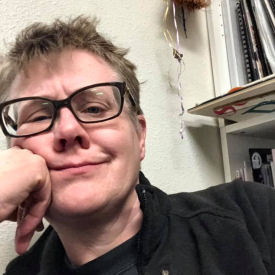






Jane, this was an excellent article. While the puppies managed to (presumably) put their nominees on the Pro Artist Hugo, it is interesting that the Fan Artist, which should be the one that has the names more recognizable to all of fandom rather than just the art buying segment, ended up with three of the usual suspects. I agree that this kerfuffle is only really important to the literature categories; the Best Dramatic Presentation nominees would have been roughly the same, as would the Podcast, and probably the Graphic Novel. The members of Worldcon have slowly tried to adapt to the changes in the field (we’re still trying to figure out handle the surge in YA literature), but as you have correctly pointed out, some of the nominees aren’t waiting around for us to work it out, they’re showing that the label “Hugo Award Winner” isn’t as valuable these days as it used to be.